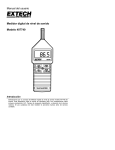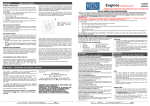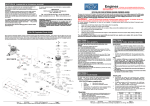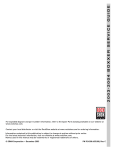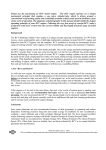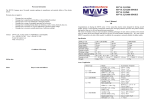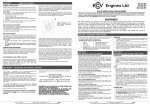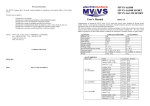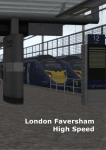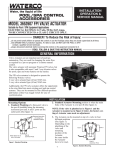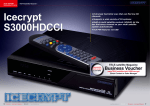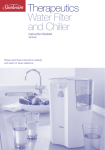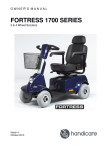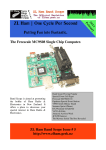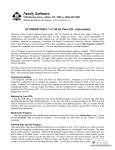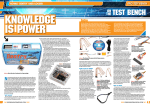Download section 9 guarantee & technical support
Transcript
SECTION 9 GUARANTEE & TECHNICAL SUPPORT Your engine is guaranteed free from manufacturing defects and workmanship for a period of 24 months from date of supply*. This warranty is limited to the original purchaser of the engine and is not transferable. This does not apply to damage caused by incorrect usage, handling, running in, non-observance of these instructions, or modification. Furthermore the manufacturers cannot be liable for any fault caused through incorrect assembly or disassembly-assembly of the engine, our factory offers a full after sales service should you require work done on your engine. For queries, warranty issues or more information on spares available, please contact: worldwide distributor: *To validate this guarantee we must receive your completed warranty form and proof of purchase (send a copy of your receipt, & keep the original) within 1 month of purchase. This guarantee does not affect your statutory rights. REMEMBER: SAFE OPERATION OF YOUR MODEL AND ENGINE IS YOUR RESPONSIBILITY. SPECIFICALLY, NO RESPONSIBILITY IS ASSUMED FOR ANY DAMAGE TO ANY MODEL, ACCESSORY, RADIO CONTROL EQUIPMENT, PERSON OR PROPERTY RESULTING FROM THE USE OR MISUSE OF AN RCV MODEL ENGINE. IF IN DOUBT CONTACT RCV ENGINES Any engines being returned to RCV must have a returns number (issued by RCV) Engines WESTON UK 84-88 London Rd, Teynham, Sittingbourne Kent , ME9 9QH, UK Tel: +44 (0)1795 521030 Fax: +44 (0)1795 522020 Email: [email protected] Web: www.westonuk.co.uk. ATTENTION-ALL RCV ENGENES HAVE BEEN TEST RUN ON PROSYNTH 2000 10% NITRO FUEL RCV58-CD FOUR STROKE ENGINE OWNERS GUIDE Thank-you for choosing an RCV Engine. With simple care this design can offer you years of trouble free service. Some aspects of the RCV engine are different to conventional engines therefore even if you are an experienced modeller please read all these instructions carefully before using your engine. Please pay particular attention to the RCV CD do’s and don’ts listed below before attempting to run your engine. READ ALL INSTRUCTIONS BEFORE OPERATING YOUR RCV ENGINE! 58-CD Exploded Parts View RCV engines are inherently reliable, however as with all engines spares will sometimes be required. If you need to order any spares you can do so either from your local hobby shop or from Westonuk direct. A list of available spares can be found on the Westonuk web shop. Some components below are only available as complete assemblies to enable RCV to keep our spares at the lowest possible prices. If you need different spares or would like help in identifying a spare please contact RCV. WARNING! :-Under no circumstances should the crankcase breather nipple be extended. If extended the oil residue can cause crankcase compression which will restrict oil lubrication to the bottom end. RC model airplanes & engines are not toys and are capable of causing serious injury to yourself and others if improperly used. You should always:• Keep hands and all foreign objects clear of the engine when it is operating. • • • • • Mount the engine securely on a bench mount or plane. Use a good quality balanced propeller with no cracks or flaws, ensure this is tightened prior to each use. Run your engine in an well ventilated area. Not hand start the engine. While the engine is running stand behind the engine to make adjustments and ensure proper safety clothing is always used (eye goggles and gloves). The safe operation of your engine is your responsibility so ensure that you operate your engine with care at all times and ensure all spectators are kept at a safe distance. SECTION 1 SECTION 3 RCV 58CD DO's & DON'Ts GLOW PLUG, FUEL & PROP SELECTION READ ALL THE INSTRUCTIONS BEFORE OPERATING YOUR ENGINE If in doubt, contact RCV Engines for advice. GLOW PLUG • ONLY USE RECOMMENDED FUELS We recommend you use a methanol based fuel containing 10% Nitro. We recommend Westonuk Liquid Gold Prosynth 2000 10% nitro fuel. For more information on fuels please see SECTION 3. ONLY USE RECOMMENDED PLUGS For reliable running we strongly recommend the use of an PP4T plug. Fitting a non-recommended plug may produce a significant drop in performance when the glow battery is disconnected.ALLOW FOR PROPSHAFT CENTRE-LINE OFFSET The propshaft centre line is offset 3 mm above the engine bearers. When installing the engine in a model ensure this is taken into account. SET UP THE CARBURETTOR CORRECTLY As supplied, the idle needle is set at rich to protect the valve. To achieve smooth running after running in, this must be adjusted as per instructions. (SEE SECTION 6) ENSURE THE EXHAUST IS PROPERLY TIGHTENED Prior to use, tighten the exhaust pipe and muffler using the recommended procedure (SEE SECTION 4) ENSURE ADEQUATE COOLING 4-stroke engines tend to run hotter than 2-strokes so provision for cooling is important (SEE SECTION 7) DO NOT USE AN IDLE BAR PLUG. This may protrude into the rotary valve, and lock the engine up, damaging the surface of the rotary valve. FUEL • For maximum efficiency, we recommend that 10% Nitro content fuel is used. Fuel with too low a Nitro content will produce a significant drop in RPM when the glow battery is disconnected as well as a less reliable idle. Do not use fuel with more than 15% Nitro as this could result in engine damage. • Recommended Westonuk Liquid Gold Prosynth 2000 10% nitro fuel. • Cheap fuels or home blended fuels may reduce the lifespan of the engine. If • If Prosynth 2000 fuel is not available we recommend a fuel with a high quality oil content with no castor. PROPELLERS SECTION 2 RECEIVING YOUR ENGINE We take every care to ensure this engine reaches you in perfect condition. If this is not the case, please advise us at the earliest opportunity. Your package should contain the following items: RCV58-CD Engine complete with:• • • • • As the glow plug on the RCV is ported, selection is more critical than on conventional engines, and fitting a non-recommended plug may produce a significant drop in performance when the glow battery is disconnected. It is strongly recommended that the Pro plug PP4T is fitted which has been specifically designed for the RCV range. Muffler • Allen Key for valve cover Carburettor • Allen Key for carburettor manifold Glow plug Warranty Form (To qualify for the 2 year warranty & lifetime repair guarantee, e must receive your completed warranty form within 30 days of purchase. • • • • The RCV58-CD engine uses conventional sized propellers. There are numerous different sizes of propellers which could be used and this is really dependent on the airframe and the type of flying. For general running in etc, RCV recommend an 11 x 6 or 12 x 6 APC type prop. These propellers give a good all round performance. Examples of suitable propellers are listed below. We would recommend you try a number of different propeller sizes and see which suits yourself and the application best. Once your engine has been fully run in, you should expect the following performance (this is a guideline only): Please Note: 1. 2. 3. Issue 13 28/10/2008 58CD © RCV Engines Ltd Page 4 This engine is subject to Global Patents and Design Copyrights inc. Int. Pat App. WO 03/062615 As part of quality control, engines are individually tested prior to despatch. Your engine will be covered in a light coating of oil used to protect it during transit. Please remove plastic plug from crankcase breather A photo user manual is also available for download from the RCV website - www.rcvengines.com Propeller Idle RPM range 11 x 6 2,200 - 2,500 8,800-10,700 12 x 6 2,200 - 2,500 8,600-9,100 11 x 7 2,200 - 2,500 8,700-10,100 Issue 13 28/10/2008 58CD © RCV Engines Ltd Page 1 This engine is subject to Global Patents and Design Copyrights inc. Int. Pat App. WO 03/062615 SECTION 4 STARTING PRIOR TO USE, PLEASE ENSURE YOUR EXHAUST IS TIGHTENED Recommended procedure for tightening your exhaust pipe Use a 14 mm spanner which has a ring spanner at one end and a conventional open spanner at the other. Use the open-ended spanner to remove the muffler. Slide the ring spanner along the exhaust pipe and locate it over the exhaust pipe lock nut. Turn the exhaust pipe to the desired angle and tighten the lock nut firmly. Slide ring spanner off down pipe. Replace silencer and tighten locking nut with open-ended spanner. Repeat the above operation with the engine warm so that the exhaust is tightened when the threads are expanded and use the maximum amount of thread. If you need a different angled exhaust pipe, you can use one that is suitable for other 4-stroke engines. RCV use standard exhaust thread sizes: – 58CD = M11x0.75 GLOW PLUG CONNECTION • Use either a conventional clip on or remote glow plug connector. disconnected although some drop in RPM may occur due to the rich mixture and comparatively low engine temperature. Leave the engine running like this for around 15 minutes. Stop it using the throttle and allow it to cool for a further 15 minutes. Now you can obtain the correct carburettor setting using the following procedure: a) Restart the engine, open the throttle wide and adjust the main needle for just slightly rich (a few rpm short of peak). b) Close the throttle to around 1/3rd and, with the engine at around 6000 rpm, screw in the secondary needle until the rough (rich) running smoothes out into a nice four-stroke note. The needles are now ROUGHLY set but you will probably have to richen the main needle on the throttle up to full power. Test and adjust before returning to 6000 rpm. c) Reliable, slow running will not be achieved until the engine has been run in for at least one hour. When this running time has elapsed you can fine tune the idle needle. NB. Close attention to the idle needle settings will pay dividends in smoothness. INSTALLING THE ENGINE IN A TEST STAND • • • WARNING. ENSURE YOU HAVE SECURELY FASTENED THE ENGINE TO YOUR TESTSTAND Ensure that the bench the engine is attached to will not be pulled over by the thrust of the engine. Fit a suitable sized quality propeller for running in. eg. APC type 12x6 (2-bladed propeller); RCV58-CD Dimensions STARTING METHOD • STARTING MUST ALWAYS BE CARRIED OUT WITH SAFETY IN MIND. Use a conventional electric starter with a correctly sized cup for your spinner. TIPS & HINTS FOR STARTING PROCEDURE 1. Eye protection should always be worn when starting and running your engine. 2. The crankshaft must be rotated anticlockwise (i.e.) the same direction as normal propeller rotation 3. On a new engine or if very cold, the engine will feel quite stiff to the turn and until the engine has had a tank or two of fuel passed through it. For initial starting purposes, we recommend needle should be 2 turns open. This should be pre-set from the factory. At all times ensure that the engine is on a low throttle setting when you start it (1/8-1/4). High throttle will make the engine difficult to turn over. 4. When you have set up the starting arrangement as described above you can now start the engine. Ensure fuel is getting through to the carb, and that the needle is open the correct amount. Turn the glow on. Hold the starter very firmly but without pressing hard. Press the starter button. The engine should immediately turn over rapidly and fire within a few seconds. 5. Under No circumstances should you keep turning the engine over if it does not fire as this may cause damage to the engine. From the earliest prototypes the RCV engine has always been an excellent starter. If the engine will not start there is always a logical reason for it. In particular check that the glow is adequate, and that fuel is getting through. If fuel doesn’t appear to be getting through, unscrew the idle needle by a ½ turn. 6. If the starter will not turn the engine over remove the starter, turn the glow off, turn the prop back to top dead centre, close the throttle slightly to reduce the compression load on the starter, turn the glow on and try again. If you do experience problems starting your engine contact RCV and we will be happy to assist SECTION 5 SECTION 6 SECTION 7 CARBURETTOR ADJUSTMENT INSTALLING IN A MODEL Main needle (high speed) adjustment: The main needle should be adjusted with the engine operating at full throttle. The engine should be leaned out until the RPM peaks, then enriched a small amount. This will allow for the leaning out that normally occurs in flight. If the engine is installed in a model, the nose of the model should be raised to the vertical to check that the engine will run without leaning out in this attitude. Note that to lean the engine out the needle is screwed in. Idle needle (low speed) adjustment: If the engine does not run cleanly at low or mid throttles the usual problem is that the idle needle is incorrectly set. This can be adjusted with the small brass screw. Please follow the guidelines below to decide how the idle needle should be adjusted. Idle Needle Adjustment Fault Finder Idle mixture too lean: There will be a tendency for the engine not to start at low throttle settings. Once it does start it will run cleanly at mid throttle but will tend to die at low throttle. It will also tend to die when the throttle is opened rapidly. In general there will be little or no increase in engine speed when the glow plug is energised. Idle mixture too rich: The engine will start readily. It will run roughly at mid throttle settings, and at idle will splutter and pop. When glow is energised the engine will run more cleanly and the idle will speed up considerably. Idle mixture correctly set: The engine will start readily and run cleanly from idle to max RPM. The idle will sound slightly rich and “poppy”. Idle speed will increase slightly when the glow is energised. The throttle can be opened rapidly without the engine stalling. NB. The idle mixture is sensitive, therefore increments of 1/8th of a turn or less are all that is normally required. Factory Needle Settings If you need to get back to the original factory needles settings, please use the info below. This is only a starting point as there is no hard fast rule. Main Needle: Screw the needle in fully and then unscrew 1 3/4 turns Idle Needle: Unscrew the needle fully out with the throttle open and then screw in 3 1/2 - 4 turns Measurements in mm RUNNING IN The running in period on any engine is critical and will affect the lifetime on your engine. • The rotary cylinder valve design on your RCV58CD incorporates close fitting components, therefore your engine will benefit from extended running in (eg. 1 - 2 hrs). Power will also increase during running in. • Do not allow the engine to overheat during running in, therefore run in short bursts. Once the engine starts for the first time, leave the glow supply connected and let the engine warm up at a fast idle speed for 30 seconds. Increase the throttle setting to about ¼, and tune the high-speed needle valve for slightly rich running i.e. a slightly burbling exhaust note (if you have a tachometer aim for around 6000 rpm). The glow supply can now be Issue 13 28/10/2008 58CD © RCV Engines Ltd Page 2 This engine is subject to Global Patents and Design Copyrights inc. Int. Pat App. WO 03/062615 The RCV CD series produces a similar amount of power to a conventional 4 stroke, therefore use the 4-stroke engine size as recommended by your model kit manufacturer. An RCV CD engine is designed to be mounted between conventional beam mount engine bearer. NB. The Prop shaft centre line is 3 mm above the bearer top face. Ensure that this is taken into account when installing the engine • Provide adequate cooling for the engine - a good guideline to follow when deciding on the necessary air outlet / inlet requirements is 2:1 or if possible 3:1. This enables hot air to escape from the cowl which is one of the main causes of overheating. • • • • • • The Carburetor may be rotated 180º to aid mounting The engine can be mounted in any configuration including in an inverted position. The fuel tank should be installed with its centre line as near as possible to the centre line of the carburettor. We recommend using the fitting provided on the silencer to pressurise the fuel tank The crankcase breather is the same as on a conventional four stroke. It cannot be used for fuel pressurisation and should simply be vented to the atmosphere A piece of fuel tubing can be attached to crankcase breather – max 6”" SECTION 8 CARE OF YOUR RCV NORMAL MAINTENANCE At the end of each days flying it is recommended that a few squirts of clean machine oil “after run oil” are introduced into the crankcase via the crank breather. If the engine is to be removed from the model and laid up for any significant period, we recommend the following:• Ensure there is no fuel left in the engine • Remove the glow plugs • Flush out the engine with good quality after-run oil • Store the engine on the plane with the nose down to keep oil in the bearings DISSASSEMBLING YOUR ENGINE Specifications Imperial Metric Displacement 0.58 cu in 9.5 cc Weight 17.96 oz 550 g Prop Shaft Dia 1/4” UNF Exhaust Thread M11 x 0.75 Mounting hole size 3.5 mm Practical rpm 2400 - 12000 rpm 2-blade Prop sizes 11x6 11x7 12x6 Glow Plug OS ‘F’ Approx. fuel consumption 0.35 fl oz / min RCV do not recommend disassembling your engine unless necessary. If you do wish to do this, please follow the instructions below 1. Remove the carburettor, exhaust & the six socket headed screws holding the crankcase together. 2. Separate the lower crankcase half and carefully remove the crankshaft/piston assembly. Take care not to lose the small plastic pad in the side of the piston. To replace the front bearing :1. Remove the pop nuts, washer, prop driver & woodruff key. 2. The piston / conrod assembly is removed together with the bronze thrust washer (note the big end position on reassembly). 3. The front bearing is a light press fit on the shaft and can normally be removed by tapping the shaft down onto a soft material (ie. hard wood or plastic). RE-ASSEMBLING YOUR ENGINE Reassembly is a simple operation & the main difficulty is ensuring that the gears are engaged in the correct position so that the engine is timed correctly. 1. Carefully remove any bearing lock material from the back bearing and the crankcase halves. 2. Assemble the crankshaft piston assy in reverse order. 3. Take the cylinder jacket and rotate the cylinder until the cylinder port is equally visible in the exhaust and inlet ports. 4. Now insert two cocktail sticks (or similar) into the exposed segments of the port to lock the cylinder in position. Insert the piston into the cylinder bore and engage the gears in such a way that the piston is at top dead centre checking that the crankshaft webb is horizontal. 5. Apply a small amount of bearing lock onto each bearing and assemble the bottom half of the crankcase with the six screws. Do not over tighten these screws. 6. Remove the cocktail sticks. Issue 13 28/10/2008 58CD © RCV Engines Ltd Page 3 This engine is subject to Global Patents and Design Copyrights inc. Int. Pat App. WO 03/062615


